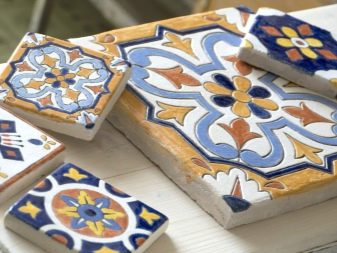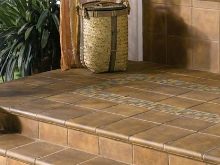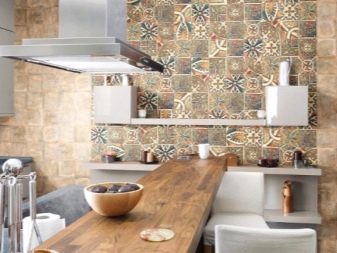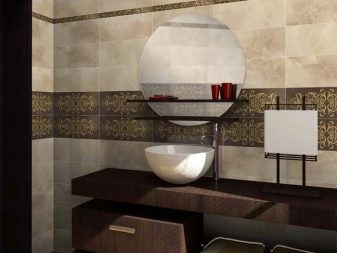Spanish tiles in the interior

Many countries are famous for the manufacture of one or another characteristic product, which becomes a feature and property of culture and history, because it reveals its roots in the distant past, bearing the imprints of a particular period of time and events. Ceramic tiles are one of these products, which is the real heritage and achievement of Spanish artisans.


The history of development
Spain has long been one of the most important suppliers of ceramics among European countries. According to some reports, it was this country that became the first manufacturer of ceramic tiles in Europe. Unusually, almost all of the companies and factories that manufacture this product are located in one area: in a province called Castellón. 50% of the population of this town (about 30,000 Spaniards) work in factories and manufacturing plants.
The tradition of making ceramics dates back several hundred years.when a deposit of scarlet clay was discovered in the Castellon region, from which Christian monks were the first to make tiles. To understand how they managed to reproduce the recipe and master the technology, it is necessary to turn to the history of Ancient Persia, where scientists discovered a kind of ceramic tile, which was probably used to decorate ancient Persian temples, royal palaces and public buildings.



All knowledge related to manufacturing, the templars kept a secret. Later, the unique recipe fell into the hands of the European monastic order, and the students were initiated into the sacrament of process and technology through the chain of succession orally. However, over time, the recipe was disclosed, and ordinary people were also admitted to the manufacturing process. Thanks to this, two directions were formed - "Aristocratic" and "Craft", where the representatives of the first were monks of various Catholic orders, who were aware of all the details and subtleties of high-quality production.
They used ceramic tiles to decorate churches, temples and houses of the local aristocracy. The members of the "Craft" movement were people from the people who were not knowledgeable and enlightened in the production and made ceramic tiles of the middle class, not very durable and not so attractive in appearance.
The provincial apprentices eventually developed into large-scale production, and Spain became the leader in manufacturing in the European market.


Peculiarities
Nowadays Spain is one of the world leaders in the production of ceramics. In the enterprises where the descendants of the first Spanish artisans now work, they still respect and treat family traditions in the most reverent way. According to ancient recipes, modern ceramic tiles are made here, modernizing them with the advent of new methods and technologies in manufacturing and painting.
The material from which ceramic tiles are cultivated is mainly clay with an admixture of natural additives. The material is pressed under high pressure and then fired in a special oven. The top layer of the tile is called “ceramic glaze”.
The Spanish product is characterized by strength and rigidity, the tiles cannot be deformed even under heavy loads. It perfectly survives the effects of household chemicals, therefore, it is used in kitchen finishes in bathrooms. The tiles are easy to clean and completely hygienic.



Views
There are several types of Spanish tiles:
- Tile. Such tiles are used in the decoration of walls and floors of baths or kitchens. A tiled version is made from various types of clay, but mainly from red. This condition undoubtedly affects both the quality and the price policy of the product.
- Clinker. This type of ceramic tile is the most durable and resistant to all kinds of adverse environmental influences. A product of this type does not require special care, but it serves for a rather long time.
- Porcelain stoneware. A similar type is used in the cladding of public structures. Due to their properties, they can be used to decorate the facades of buildings. The material has strong frost resistance, but at the same time it has a very smooth surface, therefore it is often supplemented with anti-slip bumpers.



According to the method of application, the tile is divided into 2 types:
- Wall. Has a porous surface. This makes it very easy to install it on the bathroom wall. Due to its special characteristics, the tiles are able to absorb moisture.
- Outdoor. In contrast to the porous surface of wall tiles, the floor version has a low porosity index. Such a product is able to decorate the bathroom floor, as well as it perfectly withstands the weight and does not require special maintenance.


The most common sizes are:
10x10, 20x10, 15x15, 20x20, 20x30, 25x40, 25x50, 20x50, 30x45, 25x50, 30x60, 30 x 90 cm.
Floor slabs can be square or rectangular.
The standard sizes of floor tiles are:
- Square: 48x48, 10x10, 15x15, 20x20cm;
- Rectangular: 20x10, 20x15, 30x15, 30x20cm.
For kitchen cladding, it is best to use medium-sized tiles: 20x40, 20x45, sometimes 20 by 60 cm.

The ceramic product has found its use as a facing of steps and stairs in private houses, but sometimes in large apartments. Very often, tiles that imitate wood are used for finishing staircase structures. It looks spectacular in large country houses, where a similar element is able to give warmth and the appearance of natural decoration right inside the house.
Any type of ceramic tile from the Spanish manufacturer has absolute durability, as well as a variety of colors, which allows the designer to embody his ideas and fantasies in all their glory.
Experienced builders and ordinary buyers who understand the manufacturers notice that thanks to individual combinations, ceramic tiles can fit into the interior of absolutely any style, becoming its decoration and the so-called "highlight".




Design
The design of ceramic tiles is characterized by dynamic performance and highly artistic design. The appearance of the product combines the standards of the eternally relevant classics, as well as shades of new trends in contemporary art, elements of abstraction and naturalism. Spanish tiles will be an excellent complement to both a restrained and elegant interior, as well as a peculiar, in places flashy, bright and modern design. Tastefully selected ceramics can become an element that reveals the nature of the owner, speaks of his preferences and mood.
It should be noted the technique of bright blotches on the surface of the product, which itself has a monochromatic color. Such a detail can be expressed in completely different ways. It can be some kind of embossed element, unexpected color spots, blots, patterns, ethnic ornaments and other interesting approaches.





The choice of Spanish ceramic tiles is striking in its texture and tonal variety. For example, there are tiles that look like wood, onyx, white marble, blue opal and other natural materials. In the collections of ceramics, you can find a lot of interesting, original artistic solutions. The product is often decorated with floral motifs. Sometimes it is supplemented with small borders, panels and various inserts.



Manufacturers
- Ceramicalcora - the company began its activity relatively recently, but has already managed to earn a big name for itself. Like most ceramics firms, Ceramicalcora is located in the province of Castellón. In its production, the company uses a two-stage material firing, which significantly improves the quality of the product. Thanks to the use of the latest equipment, the tones of the tiles clearly correspond to the specified characteristics. Surfaces are flawlessly smooth, plane lines and corners are perfectly maintained.
- Mapisa - the company was founded in 1973. From the very beginning of its work, its goal has been to produce world-class products. At the moment, the company produces about 12 million square meters of tiles per year, and is also a member of the HATZ industrial group.


- Grespania - has been on the ceramic tile market since 1976. The policy and goal of the company is to make products generally available to buyers of different income levels, while maintaining the quality at a high level. Due to a flexible pricing policy, the implementation and production efficiency are growing every year. There are elite lines in stock. This makes it possible for a wealthy buyer to form a unique design for kitchens and bathrooms.
- Atlantictilesprojects Is a young company using modern innovative technologies in the production process. The tile has an ultra-modern design. Special equipment and a well-built workflow make it possible to reduce the selling price of goods, which makes the tiles of this company a profitable purchase for different layers of buyers.


- Plaza - the company was founded in 1962. In 1999, she presented the first brilliant ceramic collection, which brought the company to the international market. For over 15 years, it has been producing ceramic tiles with the addition of granite chips. Thanks to careful work on the ceramic surface, the product is absolutely mirror-like and resistant to aggressive chemical influences.
All products undergo so-called "dry grinding", which makes the corners of each tile perfectly even.
- Porcelanosa - a manufacturer of branded ceramic tiles and porcelain stoneware. The company's collections keep pace with the fashion trends of the modern world. Products for flooring and walls are produced exclusively from white clay. The company is working on a technology for the production of porcelain stoneware, which externally imitates various natural materials.


- Mainzu - the company began its activity in 1964, but was closed in 1993. The reason was the desire of the manufacturer to completely modernize the system of equipment and technologies. And now, judging by the results of sales and reviews, we can say that this has played a positive role and helped the company enter the global arena of ceramic manufacturers.
- Oset Is a Spanish factory founded in 1973. It is one of the leaders among the companies producing ceramic facing products. Real professionals take part in the production. In Spain and abroad, Oset is quite popular. The factory works only with environmentally friendly materials. It is distinguished by its technology of adding metal to a ceramic product.
All of the above Spanish brands are popular not only within the country, but all over the world, including in demand in the Russian market.


Selection Tips
Most of the collections of Spanish tiles belong to the expensive range of goods. The result of a successful purchase should be a complete transformation of the premises.
Otherwise, which is very rare, incorrectly selected products will be discordant with the overall picture of the room and will cause wasted money and time. Sometimes such cases lead to complications in the process of repair work.
Problems can arise at any stage of the construction process.It becomes more difficult to correct errors if the room is lined at the final stage of repair work.



When choosing a tile for indoor installation, you must take into account some of the nuances:
- You shouldn't save money on buying a truly high-quality product. You should study the reviews of trusted manufacturers and create a clear picture with a description of the product that will meet all the stated requirements. The optimal price for high-quality Spanish tiles is at least 1000 rubles. / m2. Too high prices - manufacturers' markup for the brands offered.
- It is best to opt for a complete collection of tile products.
- The matte surface has a lower percentage of slipping. However, a glossy-looking wall covering is easier to clean and looks much better.
- There are special borders in the product collections, but it is not advisable to use them in the arrangement of small rooms.


- The use of borders is possible if it is necessary to divide tiles of different color shades in a contrasting way. Usually this element is used for large rooms with minimal furniture. In the bathrooms, for example, there is not much space, because there are oversized equipment that divides the already small space into separate sections. Curbs in this case are an absolutely useless part.
- Floor tiles in dark colors will look more attractive, and wall tiles should contain light shades. This creates the illusion of expanding space.
- Dark floor tiles are less dirty and easier to clean. Wall cladding with rows of dark tiles should be made in such a way that the last row protrudes 12-15 cm above the edge of the bathtub.
- For gluing the product to the surface of the floor or walls, you must choose high-quality glue.



Beautiful examples in the interior
Signature Spanish ceramic tiles embody the rich experience of the past and innovative developments of the present. Who knows how much this creative process will change in the future. Diverse and dissimilar collections of ceramic tiles are constantly being improved. This makes it possible to realize unique design ideas, finding a variety of ways for this.
The tile design of the kitchen room corresponds to the most fashionable trends, and also makes the room bright and modern, refreshes its appearance and gives the atmosphere a positive note.
Spanish tiles in the interior of a modern kitchen.


Stylish solutions in the decoration of the hall using ceramic tiles are so diverse that you can choose a product that fits perfectly into the color scheme of the room and its general mood.

You can find out more information about Spanish tiles in the video.













The comment was sent successfully.